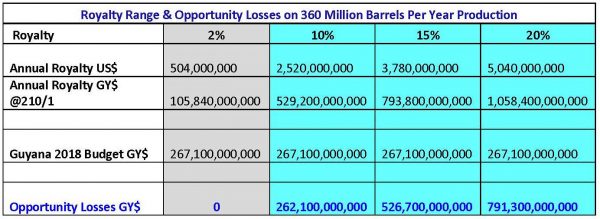With both major parties wedded to the belief that they must be good ambassadors for Exxon’s Esso, the race to genuflect lower before Exxon, has already cost Guyana billions of dollars. Exxon’s Esso controls over eleven million acres in and around the prized Stabroek Block, including 6.6 million acres of the Stabroek Block.
Guyana’s super quality offshore oil has several other investors that are shell companies for Exxon or Exxon’s Esso, with Exxon having option agreements to control or buy out the other investors share. Thus, Exxon is the majority holder for the Stabroek, Canje and Kaieteur blocks combined.
Using one million barrels of oil produced per day, as the likely amount of oil, Guyana will be producing by 2025 at a price per barrel of US$70, the table below illustrates the opportunity losses Guyana suffers at a 2% Royalty level.

Too many of the local and international oil experts and commentators are either shilling for Exxon’s Esso or raging an epic battle in the margins; over tax concessions, environmental issues, hiring of oil specialists, institutions that need to be organized or other triflings or non-core issues that distract from the essential need; i.e. the rotten 2% royalty, which is the choking hold on the throat of every Guyanese and denies us our God given wealth. The 2% royalty is a sword of injustice against a small nation state that must be changed. As can be seen from the table above, even at a modest 10% royalty – GY$262 Billion will go into our budget to invest in the people of Guyana, infrastructure, industries, health and education.
It does appear to me that most of the criticisms now being made are not against the beastly 2% contract, but rather, about how we should best locate ourselves to execute the unconscionable contract.
An almost irrelevant issue is the 50/50 profit share arrangement in the production sharing agreement, which is all hot air or just plain superfluous. Show me any agreement where Exxon is paying a royalty and then giving 50% of profits after royalty and proven costs, and I will show you a flying elephant.
We must focus on changing the component of the contract that makes it unconscionable; the component is the 2% royalty that has to be changed to at least 10%.
With the super quality oil discovered in our off-shore territory, and much more discoveries expected, oil majors would happily pay 20% royalty to Guyana, plus repay Esso’s exploration costs to date at a 10% mark-up; in exchange for the position that Exxon’s Esso has in the Stabroek Block.
When analysts, experts and commentators, who purport to be speaking or writing in Guyana’s best interest, focus on non-royalty issues and side-track to the process and procedures of executing the production sharing agreement, instead of having the egregious 2% changed; think of duckspeak, superfluous babble, politicking or hired guns.
The Stabroek Block has the largest and most valuable oil find of the century. If Guyana secures one hundred of the most qualified and competent oil experts in the world, these experts would be no match for Exxon’s resources in human, technological, environmental or economic capacity. Thus, focusing on hiring oil experts to monitor Exxon’s experts is a fool’s errand and a complex and useless task for the finest oil experts that we can hire. Unlike receiving a percentage of royalty on gross price, which can be easily monitored. Again, we must focus with laser like intensity on obtaining a royalty greater than or equal to 10%.
Exxon’s Esso are misdirecting Guyanese, via their shills and shells. The major political parties’ fixation is on winning the General Elections and they are acting in an acquiescent and submissive manner to gain favour with the United States of America through one of its original and most powerful corporations. Thus, we have our native politicians being divided and ruled by Exxon’s Esso, with their direct and indirect support of a contract that is ridiculous for its unparalleled low royalty and unconscionable nature. The benefits to Guyana of having a 10% royalty contract, will massively exceed any benefits that may come from any political party being in power. Thus, all parties and private sector organizations should focus on renegotiation or rescinding of the 2% contract, now.
Whichever party wins the election, will not change the hundreds of billions of Guyana dollars that will be lost under the abusive 2% contract from 2020 to 2030 that will extend to opportunity losses amounting to trillions of Guyana dollars through to 2040 and beyond. The monies should instead come to Guyana’s benefit. Our political leaders and private sector organizations must unite and use our sovereign, constitutional and executive powers to change the contract, to at least a minimum 10% royalty contract.
The mighty United States Justice Department along with the United States Environmental Protection Agency; agencies that have several thousand-fold more in resource capacity than Guyana’s best possible monitoring systems and structure, is easily outmanoeuvred by Exxon’s network of power and resources. It is witless for Guyana to expend unnecessary resources, to do what the United States Government cannot do with its economic, scientific and technological supremacy or for us to contemplate such folly.
Nigel Hinds
August 6th, 2018






